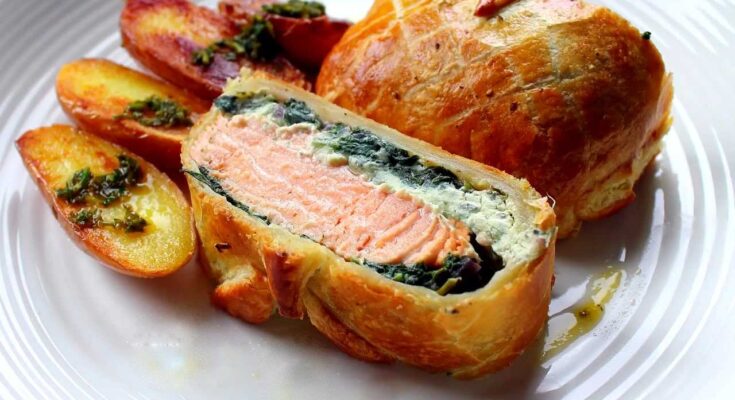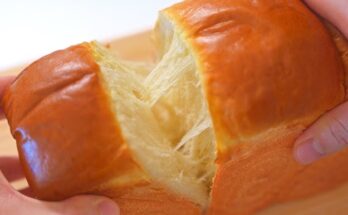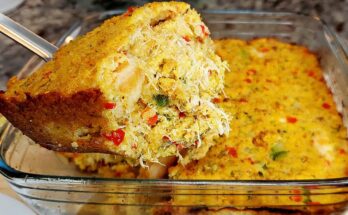Salmon Wellington Recipe: Imagine a rich, buttery salmon fillet tucked inside a golden, flaky puff pastry, layered with savory mushroom duxelles and wilted spinach. That’s Salmon Wellington, the seafood version of the famous Beef Wellington. This dish is luxurious, elegant, and surprisingly easy to make at home. It’s perfect for holidays, romantic dinners, or any occasion that calls for a showstopper meal.
Salmon Wellington, sometimes referred to as “salmon en croûte,” is a classic dish in many fine-dining establishments. But you don’t need a culinary degree to pull it off. Once you master the steps, it’ll become your go-to when you want to impress without stress.
Why You’ll Love This Recipe
Let’s be real—there are dozens of salmon recipes out there. So, why this one?
- It’s visually stunning – that golden puff pastry crust makes it look straight out of a fancy restaurant.
- Incredible flavor – flaky fish, earthy mushrooms, garlic, cream cheese, herbs—every bite is a burst of umami goodness.
- Simple ingredients – no need for anything exotic. Most items are pantry staples or easily found.
- Customizable – vegetarian? Gluten-free? You can modify this dish to fit your needs.
Plus, this recipe is a true conversation starter. Bring it to a holiday table or dinner party, and everyone will ask, “How did you make that?!”
Ingredients You’ll Need
Main Ingredients
Here’s your grocery list. Double-check it before you start, because each ingredient plays a key role:
- Salmon fillets – center-cut, skinless, and boneless. Go for fresh if you can, 6-8 oz per portion.
- Puff pastry sheets – frozen, then thawed. Use all-butter puff pastry for best flavor.
- Egg yolk – for egg wash to give that shiny, golden finish.
- Olive oil or butter – to sauté the filling.
- Shallots or onion – adds mild sweetness and depth to the mushroom mix.
- Garlic cloves – minced, for aromatic richness.
- Mushrooms – finely chopped; cremini, button, or a mix works great.
- Fresh spinach – wilted down for texture and nutrition.
- Cream cheese or goat cheese – creamy layer that adds tang and moisture.
- Dijon mustard – optional, adds a slight kick under the salmon.
Optional Add-ons for Extra Flavor
Want to take it up a notch? These additions can elevate your Wellington:
- Lemon zest – brightens up the richness.
- Parmesan cheese – grated into the filling for more umami.
- Fresh herbs – dill, thyme, or parsley all work beautifully.
- Prosciutto slices – layer under the salmon for a salty, crispy edge.
Ingredient Substitutions
Working with dietary restrictions or missing a few things? Try these swaps:
- Gluten-free puff pastry – several brands offer this; just handle it gently.
- Vegan cream cheese and plant-based puff pastry – for a dairy-free option.
- Canned salmon – not recommended, but in a pinch, go for the solid kind and drain well.
- Kale instead of spinach – just chop it finely and cook longer.
Kitchen Tools You’ll Need
Essential Equipment
Making Salmon Wellington doesn’t require a lot of fancy tools. Here’s what you need to get the job done right:
- Oven – preheated to 400°F (200°C) for even baking.
- Baking sheet or tray – line with parchment paper to prevent sticking.
- Skillet – for cooking the mushroom and spinach filling.
- Sharp knife – to clean and portion the salmon, and score the pastry.
- Pastry brush – to apply the egg wash for that golden crust.
- Rolling pin – helpful if your puff pastry needs a little thinning out.
Helpful Tools for a Smoother Process
While not essential, these tools can make your life easier:
- Food processor – to finely chop mushrooms quickly.
- Fish spatula – for gently flipping or moving delicate salmon pieces.
- Thermometer – if you’re unsure about doneness, aim for 125–130°F internal temp.
Getting organized before you start will save you from scrambling halfway through. Think of it like prepping your battlefield—mise en place is your secret weapon.
Step-by-Step Guide to Making Salmon Wellington
Step 1: Preparing the Salmon
Start with fresh, skinless salmon fillets—about 6 to 8 ounces each. Pat them dry with paper towels and season both sides generously with salt, pepper, and a squeeze of lemon juice. This helps to enhance the natural flavor of the salmon. Set the fillets aside while you prepare the filling and pastry.
Step 2: Making the Spinach-Mushroom Filling
In a skillet, heat a tablespoon of butter or olive oil over medium heat. Add chopped onions, minced garlic, and sliced mushrooms, sautéing until soft and golden. Stir in fresh spinach and cook until wilted. Season with salt, pepper, and a pinch of nutmeg. Remove from heat and let it cool slightly before mixing in cream cheese or ricotta to create a rich, creamy texture. This savory filling keeps the salmon moist and adds layers of flavor inside the pastry.
Step 3: Wrapping with Puff Pastry
Preheat your oven to 400°F (200°C). Roll out a sheet of store-bought puff pastry on a lightly floured surface. Place a spoonful of the spinach-mushroom filling in the center, then set the salmon fillet on top. Add another small layer of filling over the salmon. Gently fold the pastry over the salmon, sealing the edges tightly. Brush the top with beaten egg wash for a glossy, golden finish. You can use a fork to crimp the edges and make small decorative slits on top to allow steam to escape.
Step 4: Baking to Perfection
Place the wrapped salmon seam-side down on a parchment-lined baking tray. Bake for 20–25 minutes, or until the pastry is puffed and beautifully golden brown. The internal temperature of the salmon should reach 145°F (63°C). Avoid overbaking—the goal is flaky salmon inside a crisp, buttery shell.
Step 5: Resting and Serving
Once baked, let the Salmon Wellington rest for 5–10 minutes before slicing. This allows the juices to settle and keeps the pastry from falling apart. Slice carefully with a sharp knife and serve with lemon butter sauce, hollandaise, or a drizzle of dill cream.
Crispy on the outside, tender on the inside, and bursting with creamy, savory goodness—Salmon Wellington is a show-stopper that’s as elegant as it is comforting.
Tips for the Perfect Salmon Wellington
Avoiding Common Mistakes
Even experienced cooks can run into trouble with Wellington. Here’s how to stay on the safe side:
- Don’t overfill the pastry – Too much filling will burst the seams during baking.
- Keep everything cold – Cold salmon, cold filling, and cold pastry are key to preventing sogginess.
- Use dry fillings – Cook out all moisture from mushrooms and spinach.
- Seal the pastry well – Use a bit of water or egg wash on the edges for a tight seal.
- Score the top gently – This helps steam escape and gives that beautiful, decorative finish.
- Don’t skip the egg wash – It’s what makes the crust glossy and golden.
These little adjustments make a big difference. A successful Wellington is all about attention to detail.
Making Ahead and Freezing
Plan Ahead Like a Pro
Salmon Wellington may look fancy, but it’s surprisingly freezer-friendly and make-ahead friendly—perfect for holidays, dinner parties, or just staying ahead on meal prep.
How to prep ahead:
- Assemble up to a day in advance.
- Wrap your salmon and filling in puff pastry.
- Score the top, brush with egg wash, and refrigerate, uncovered, on a baking sheet.
- This helps the pastry firm up and gives better results in the oven.
Freezing instructions:
- You can also freeze unbaked Salmon Wellington:
- Assemble as usual.
- Skip the egg wash for now.
- Wrap tightly in plastic wrap, then foil.
- Freeze for up to 2 months.
Baking from frozen:
- No need to thaw—just unwrap and place directly on a baking tray.
- Add egg wash.
- Bake at 375°F (190°C) for 35–40 minutes, checking internal temperature.
Why it works:
Freezing stops the pastry from getting soggy, and the slow bake gives the salmon time to cook through. Just be mindful not to overbake—no one wants dry fish wrapped in crust.
Serving Suggestions
Best Side Dishes
Salmon Wellington is the main event, so side dishes should complement without competing. Here are a few ideas:
Light Veggies:
- Roasted asparagus with lemon and olive oil
- Green beans almondine
- Steamed broccoli with garlic butter
Salads:
- Arugula salad with cherry tomatoes and balsamic glaze
- Citrus fennel salad for a fresh contrast
Potatoes & Grains:
- Garlic mashed potatoes
- Lemon herbed couscous
- Wild rice pilaf
Sauces:
- Lemon dill cream sauce
- White wine butter sauce
- Simple crème fraîche with herbs
Keep the flavors light and zesty to balance the richness of the pastry and salmon.
Ideal Wine Pairings
Pairing wine with Salmon Wellington is all about balance—acidity, richness, and complementary notes.
White wines:
- Chardonnay – buttery and oaky versions mirror the pastry’s richness.
- Sauvignon Blanc – bright and citrusy, great with spinach and herbs.
- Viognier – aromatic and slightly floral for a delicate contrast.
Rosé options:
- Dry rosé works surprisingly well, adding fruitiness and balance without overpowering.
For red wine lovers:
- Try a Pinot Noir – its light body and earthy notes match beautifully with mushrooms and salmon.
The goal is harmony—let the wine elevate the meal, not drown it.
Storage and Reheating Instructions
How to Store Leftovers
Even though it’s best fresh, Salmon Wellington can be stored for later enjoyment.
- Cool completely before refrigerating.
- Wrap tightly in foil or place in an airtight container.
- Store in the fridge for up to 2–3 days.
Avoid plastic wrap directly on the pastry—it traps moisture and makes it soggy.
Best Way to Reheat Without Soggy Pastry
- Preheat your oven to 350°F (175°C).
- Place the Wellington on a baking sheet.
- Heat uncovered for 10–15 minutes, or until the center is warm.
Pro tip:
Place a piece of foil loosely over the top to prevent the crust from browning too much while still heating the inside.
Avoid the microwave—it’ll turn your perfect puff pastry into a limp mess.
Nutritional Information
Calories and Macros
Here’s an approximate breakdown per serving (based on a 6 oz salmon fillet and 1 sheet of puff pastry):
| Nutrient | Amount per Serving |
|---|---|
| Calories | 600–700 kcal |
| Protein | 30–35g |
| Carbohydrates | 30–35g |
| Fats | 40–45g |
| Fiber | 2–4g |
Note: This will vary depending on fillings (cheese, cream, etc.), pastry brand, and serving size.
Health Benefits of Salmon Wellington
- High in Omega-3s – thanks to the salmon, your heart and brain will thank you.
- Protein-packed – excellent for muscle repair and metabolism.
- Rich in B vitamins – supports energy levels and cell health.
- Spinach bonus – full of iron, calcium, and antioxidants.
While this is a richer meal, it brings a good mix of nutrients—especially when paired with healthy sides like greens or roasted vegetables.
Variations of Salmon Wellington
Keto or Low-Carb Version
Looking to enjoy Salmon Wellington without the carb overload? It’s totally possible with a few smart swaps.
Low-carb pastry options:
- Fathead dough – made from mozzarella, cream cheese, almond flour, and egg. It’s pliable and crisps up beautifully.
- Cauliflower crusts – trickier to wrap, but work well for a bottom-only crust or open-face style.
Other keto-friendly tips:
- Skip any added breadcrumbs in the filling.
- Use full-fat cream cheese or mascarpone for added richness and flavor.
- Load up on herbs like dill, basil, or chives for that punch without sugar or starch.
You’ll still get the elegance and flavor of the original dish, with a fraction of the carbs—perfect for keto diets or anyone watching their intake.
Vegetarian Twist
No salmon? No problem. You can still make an equally impressive dish using vegetarian ingredients.
Ideas for a meat-free filling:
- Portobello mushrooms – large, meaty, and satisfying. Marinate them in balsamic and herbs before wrapping.
- Tofu or tempeh – seasoned and seared, then layered with spinach and creamy cheese.
- Lentils or chickpeas – mashed with garlic, herbs, and cheese to create a hearty center.
Extra flavor boosters:
- Add sun-dried tomatoes, roasted red peppers, caramelized onions, or pesto for more depth.
- Use vegan puff pastry and plant-based cheeses for a fully vegan version.
It’s a great way to enjoy the drama and decadence of Wellington while staying meat-free.
FAQs about Salmon Wellington Recipe
1. Can I make Salmon Wellington ahead of time?
Yes! Assemble it fully and store it in the fridge for up to 24 hours before baking. For longer storage, freeze it unbaked and cook directly from frozen when ready.
2. What kind of salmon is best for this recipe?
Opt for center-cut, skinless, boneless fillets—about 6 to 8 oz per person. Fresh is best, but frozen (thawed) works too. Avoid thin tail-end pieces, which may cook unevenly.
3. Can I use frozen puff pastry?
Absolutely. Most people do. Just be sure to thaw it completely in the fridge before using, and keep it cold before baking to prevent it from getting too soft or sticky.
4. How do I prevent the pastry from getting soggy?
Make sure your filling is dry, cool all components before assembly, and don’t overstuff. Brushing a thin layer of Dijon mustard under the salmon can also create a moisture barrier.
5. What’s the best sauce to serve with it?
A lemon dill cream sauce or a white wine butter sauce pairs beautifully. Even a dollop of herbed crème fraîche or simple garlic aioli can elevate the dish without overpowering the salmon.
Final Thoughts
Salmon Wellington is more than just a dish—it’s a statement. It says, “I made something beautiful, delicious, and unforgettable.” Whether you’re serving it at a holiday dinner, a romantic evening, or just because you feel like being fancy on a weeknight, this recipe delivers every time.
From the crispy, golden puff pastry to the flaky, juicy salmon inside, it’s a symphony of textures and flavors. And the best part? It’s surprisingly easy to pull off once you break it down into simple steps.
With this comprehensive guide, you’re equipped to make a restaurant-worthy Salmon Wellington in your own kitchen. Don’t be surprised when it becomes your most-requested recipe.



